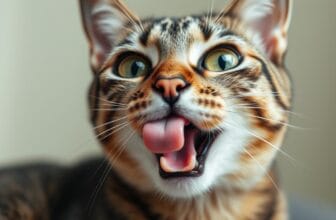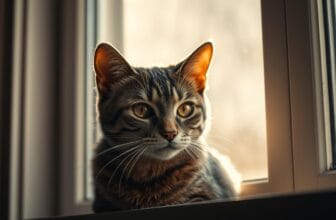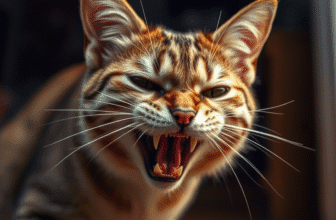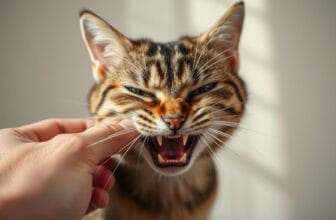
Table of Contents
Cats are typically known for their pristine grooming habits and fastidious nature. So when your feline friend starts leaving wet spots on your lap, furniture, or favorite blanket, it’s natural to feel a mix of confusion and concern. Cat drooling is far more nuanced than most pet owners realize – a complex physiological response that can signal anything from pure contentment to potential medical emergencies.
In the intricate world of feline health, understanding why cats drool is crucial. This comprehensive guide will take you on a deep dive into the various reasons behind cat salivation, helping you distinguish between harmless quirks and potential warning signs. Whether you’re a first-time cat owner or a seasoned feline enthusiast, you’ll gain invaluable insights into this often-misunderstood aspect of cat behavior.
The Physiology of Feline Salivation: Understanding the Basics

What is Cat Drool?
Saliva is more than just water. In cats, it’s a complex fluid produced by salivary glands that serves multiple critical functions:
- Lubrication: Helps with swallowing and initial food breakdown
- Oral Health: Contains enzymes that fight bacteria
- Temperature Regulation: Assists in cooling through evaporation
- Wound Healing: Possesses antibacterial properties
Normal Salivary Production vs. Excessive Drooling
While cats aren’t notorious droolers like dogs, some level of salivation is entirely normal. The key is understanding the difference between occasional and excessive drooling.
Exploring the Spectrum of Cat Drooling: From Harmless to Serious
1. Emotional and Comfort-Related Drooling
Contentment Drooling
Some cats produce excess saliva when they’re experiencing extreme pleasure and relaxation. This typically occurs during:
- Intense, prolonged petting sessions
- Deep, rhythmic kneading
- Moments of absolute trust and security
- Nostalgic memories of kittenhood nursing
Insider Tip: Cats who drool during positive interactions are essentially displaying a form of emotional vulnerability, showcasing their complete trust in you.
Anticipatory Drooling
Cats may also salivate in anticipation of something pleasurable:
- Approaching mealtime
- Hearing a can opener
- Smelling favorite treats
- Watching you prepare their food
2. Dental and Oral Health Complications
Dental Disease: The Silent Drool Trigger
Oral health issues are the most common medical cause of cat drooling:
Periodontal Disease Stages
- Gingivitis: Early-stage gum inflammation
- Periodontitis: Advanced gum and tooth root infection
- Advanced Dental Disease: Potential tooth loss and systemic health risks
Warning Signs of Dental Problems:
- Persistent bad breath
- Red, swollen gums
- Visible tartar buildup
- Difficulty eating
- Pawing at the mouth
- Drool that appears bloody or discolored
Oral Tumors and Growths
Unexpected drooling can indicate more serious conditions:
- Benign and malignant mouth tumors
- Inflammatory growths
- Viral papillomas
- Oral cancer
3. Systemic Health Conditions Manifesting Through Drooling
Respiratory Infections
Certain respiratory conditions can trigger increased salivation:
- Feline Calicivirus
- Feline Herpesvirus
- Chronic upper respiratory infections
- Viral and bacterial respiratory diseases
Gastrointestinal Disorders
Digestive issues frequently manifest through drooling:
- Nausea
- Acid reflux
- Intestinal blockages
- Food allergies
- Inflammatory bowel disease
4. Neurological and Systemic Health Concerns
Neurological Conditions
Drooling can be a neurological symptom:
- Nerve damage
- Brain tumors
- Facial nerve paralysis
- Stroke indicators
- Cranial nerve disorders
Systemic Diseases
Serious underlying health conditions can cause salivation:
- Kidney disease
- Liver dysfunction
- Diabetes complications
- Autoimmune disorders
- Endocrine imbalances
Advanced Diagnostic Approaches

When to Seek Veterinary Intervention
Immediate Red Flags
Contact your veterinarian IMMEDIATELY if drooling is accompanied by:
- Sudden, unexplained onset
- Significant behavioral changes
- Dramatic weight loss
- Difficulty swallowing
- Visible mouth abnormalities
- Persistent drooling beyond 24-48 hours
Diagnostic Procedures
Veterinarians typically employ:
- Comprehensive physical examination
- Detailed medical history review
- Blood panel tests
- Oral cavity inspection
- Potential imaging (X-rays, ultrasound)
- Specialized diagnostic tests
Prevention and Proactive Care Strategies
Dental Hygiene Protocols
- Annual professional dental cleanings
- Regular home teeth brushing
- Dental-specific cat diets
- Dental treats and toys
- Water additives for oral health
Holistic Health Maintenance
- Balanced, high-quality nutrition
- Regular veterinary check-ups
- Stress management
- Environmental enrichment
- Hydration monitoring
Supplements and Supportive Care
- Omega-3 fatty acids
- Probiotics
- Immune system boosters
- Dental health supplements
Conclusion: Empowering Cat Owners Through Knowledge
Understanding cat drooling transforms a seemingly mysterious behavior into a valuable health indicator. By staying observant, proactive, and informed, you can ensure your feline companion’s optimal health and well-being.
Have you experienced unusual drooling with your cat? Share your story in the comments, and help fellow cat owners become more aware and informed!
FAQ : Cat Drooling
Is occasional drooling during petting normal?
Yes, some cats drool when extremely relaxed. This behavior mimics kittenhood nursing and indicates deep comfort and trust. As long as the drooling is moderate and context-appropriate, it’s typically harmless.
How much drooling should raise concern?
Occasional, small amounts of drool are normal. However, persistent drooling, changes in saliva consistency, color, or accompanying symptoms warrant veterinary attention.
Can stress cause excessive cat drooling?
Absolutely. Stress triggers can include:
Household changes
New pets
Moving
Loud noises
Changes in routine Stress-induced drooling is usually temporary and resolves once the stressor is removed.
Are certain cat breeds more prone to drooling?
While most cats aren’t excessive droolers, some breeds like Persians might drool more due to facial structure. However, breed-specific drooling remains relatively uncommon.
What foods or substances might trigger drooling?
Potential drool-inducing substances include:
Bitter medications
Toxic plants
Spoiled food
Certain strong flavors
Some cleaning products
How can I prevent dental issues causing drooling?
Prevention strategies:
Regular teeth brushing
Annual dental check-ups
Dental-specific diets
Oral health treats
Professional cleanings
Regular mouth inspections
Is drooling always a sign of pain in cats?
Not always, but persistent drooling combined with other symptoms like reduced appetite, behavioral changes, or visible discomfort can indicate pain or underlying health issues.







